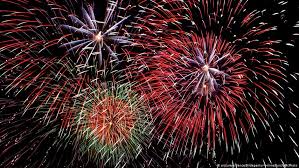
The New Year, which many believe will be full of hope, fortune, and more prosperity than the previous year, has many customs and superstitious beliefs associated with it. The United States, like many other countries of the world, celebrate the New Year with its own share of customs that you can learn about below!
- Fireworks is one of the traditions of the New Year, often starting several days before and culminating at midnight on New Year's Eve. Actually, this custom most likely started in China, since China invented fireworks. The Chinese set off fireworks to scare off evil spirits and misfortune.
- Auld Lang Syne is a traditional New Year's song that roughly means "for old times' sake". This song was the brainchild of 18th century Scottish poet, Robert Burns. The song is about the friendship and kindness of days gone by, but gives a sense of belonging and fellowship into the future according to Scotland.org, opens a new window.
- A kiss at midnight, according to Montreal Gazette, is a custom that may have started in ancient European times to ward off evil spirits. Commonly, a kiss at midnight is to ensure the coming year will not be filled with loneliness.
- The custom of eating black-eyed peas, or Hoppin' John (a stew made with black-eyed peas), is observed in the hope of bringing prosperity in the New Year. This tradition started in the South during the time of the Civil War. Even though the tradition of eating black-eyed peas started in America in the South during the time of the Civil War, the consumption of black-eyed peas on New Year's has been considered lucky for more than 1,500 years. According to the Talmud around 500 A.D., the Jewish custom of eating black-eyed peas was in celebration of the Rosh Hashanah (the Jewish New Year).
- Eating cabbage, or a leafy green vegetable, is another southern New Year's Day tradition that started around the Civil War. The cabbage represents the hopes of prosperity, with the green leaves specifically representing money in the coming year.
- Celebrating in Times Square, New York with the dropping of the giant ball at the stroke of midnight has taken place since 1907. Over the years, the ball has transitioned from a 700-pound iron and wood orb to a brightly patterned sphere that is 12 feet in diameter and weighing in at nearly 12,000 pounds.
- Making New Year's resolutions or goals in hopes of having a better year than the previous year is a practice that was believed to have started with the Babylonians, who made promises in order to earn favor from the gods and start the new year on the right foot.
More superstitious beliefs:.
- It is considered bad luck to do any hard work on New Year's Day.
- Crying or wailing on New Year's Day is also considered unlucky.
- Washing hair on New Year's Day is thought to "wash" away the good fortune of the person washing their hair.
- At midnight, doors of the house should be opened to let the old year out.
- Pantries should be stocked with food and wallets with money to ensure continued prosperity in the coming year.
- Toss a bucket of water out of the window or a cup of water over your shoulder to get rid of last year's tears.
- Well before midnight, clean the house thoroughly--being sure to clean under beds and put garbage away from house--to remove bad experiences from the past year.
- Babies born on New Year's Day are considered lucky throughout their lives.
More New Year's superstitions can be found here, opens a new window.
Source:
Beliefnet. The Meaning of New Year's Traditions.
Lee, Jolie. New Year's Traditions Explained. USA Today.Network.


Add a comment to: New Year’s Traditions in the United States